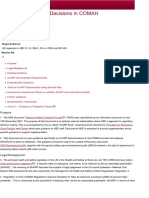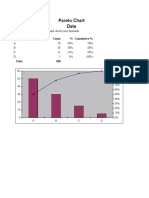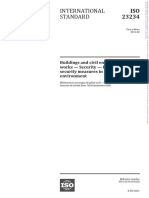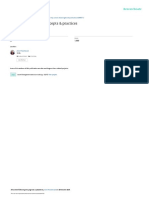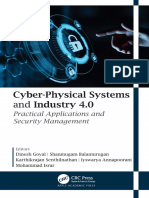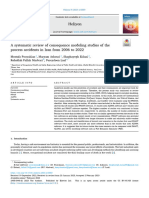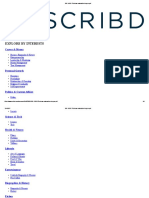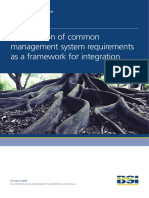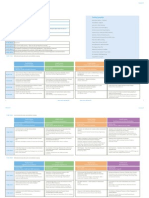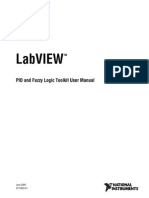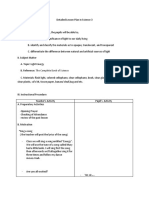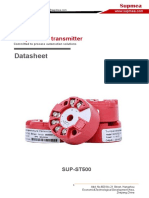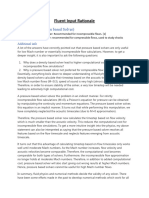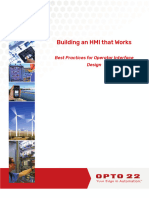SWIFT Technique in Healthcare Risk Management
Uploaded by
fairooz mohideenSWIFT Technique in Healthcare Risk Management
Uploaded by
fairooz mohideenRisk Management
Beyond FMEA: The structured what-if
technique (SWIFT)
By Alan J. Card, MPH,
CPH, CPHQ James R. Although it is probably the best-known prospective hazard analysis
Ward, BEng, CEng, (PHA) tool, failure mode and effects analysis (FMEA) is far from the
PhD, MIET, and P. John only option available. This article introduces one of the alternatives:
Clarkson, PhD, BA(Eng)
The structured what-if technique (SWIFT). SWIFT is a flexible, high-
level risk identification technique that can be used on a stand-alone
basis, or as part of a staged approach to make more efficient use
of bottom-up methods like FMEA. In this article we describe the
method, assess the evidence related to its use in healthcare with
the use of a systematic literature review, and suggest ways in
which it could be better adapted for use in the healthcare industry.
Based on the limited evidence available, it appears that healthcare
workers find it easy to learn, easy to use, and credible. Especially
when used as part of a staged approach, SWIFT appears capable
of playing a useful role as component of the PHA armamentarium.
BA C K GR O U N D
Patient safety risk management has traditionally been retrospective in nature,
aimed at solving problems that have already occurred. Root cause analysis is
perhaps the best-known example of this approach. There is broad consensus
in the wider risk management community that waiting for something to go
wrong before developing preventive measures is not enough, and since the
mid-1960s a number of prospective hazard analysis (PHA) techniques have
been developed in other high-risk industries. It wasn’t until the 1990s, how-
ever, that these techniques began to make their way into the healthcare sector,
and it was not until 2001 that the Joint Commission began requiring their use
by organizations they accredit.(1)
One of the most widely used formal PHA techniques in healthcare is failure mode
and effects analysis (FMEA),(2) and its siblings, healthcare failure mode and effects
analysis (HFMEA)(3) and failure mode, effects, and criticality analysis (FMECA).
(4) But, although FMEA may be the first method to come to mind when many
healthcare risk managers consider PHA, it is far from the only method available.
Through its Patient Safety Research Portfolio, the UK Department of Health
funded a research project that led to the development of a prospective hazard
analysis (PHA) tool kit to support the integration of PHA techniques into
healthcare risk management.(5) The PHA tool kit includes a new method—the
© 2012 American Society for Healthcare Risk Management of the American Hospital Association
Published online in Wiley Online Library (wileyonlinelibrary.com) • DOI: 10.1002/jhrm.20101
AMERICAN SOCIETY FOR HEALTHCARE RISK MANAGEMENT • VOLUME 31, NUMBER 4 23
JHRM20101.indd 23 4/6/12 5:46:50 PM
20400861, 2012, 4, Downloaded from https://onlinelibrary.wiley.com/doi/10.1002/jhrm.20101 by University Of Twente Finance Department, Wiley Online Library on [02/11/2024]. See the Terms and Conditions (https://onlinelibrary.wiley.com/terms-and-conditions) on Wiley Online Library for rules of use; OA articles are governed by the applicable Creative Commons License
result that was replicated in a study comparing SWIFT to
Exhibit 1: HFMEA in a healthcare setting.(10) This time savings is
a significant advantage. The corresponding disadvantage
Pre-existing PHA and Supporting Methods is that some hazards may be overlooked when using the
Included in the PHA Tool Kit.(5) SWIFT approach that would be identified using the more
detail-oriented HAZOP or FMEA.(10)
SWIFT need not be used on a stand-alone basis, however.
Hazard and operability studies (HAZOP) As with the PRR described above, it can be used as the
The structured what-if technique (SWIFT) first part of a staged approach to identify quickly pro-
Human error assessment and reduction technique cesses and subsystems for which it would be worth the
(HEART) investment of conducting an FMEA, HAZOP, FTA, or
other detail-oriented risk assessment. This approach has
Failure mode and effects analysis (FMEA)
the potential to reduce the overall amount of time and
Barrier analysis tedium(11) involved significantly, without sacrificing rigor.
Influence diagrams Similarly, although the outputs of a SWIFT are qualitative,
Fault-tree analysis (FTA) the technique can be used to identify subsystems/processes
Event-tree analysis (ETA) that could benefit from a quantitative PHA approach.(12)
Absolute probability judgment (APJ) Because SWIFT is a workshop-based technique in which
Risk matrices potential risks are elicited from participants, it is impor-
tant to assemble the right team when using this approach.
Ideally this should include the representation of all stake-
preliminary risk review (PRR)—which provides an initial holder groups and those with the most intimate knowl-
risk assessment and also serves as a scoping and screening edge of the system or process being assessed (often front-
tool, helping users to determine which parts of the system line workers). SWIFT is very dependent on participants’
or process of interest require a more in-depth analysis. knowledge of the systems and processes being assessed.
(5,6) In addition to producing a more valid risk assessment,
including these participants can have another important
This research also identified a number of existing PHA benefit: Participating in the SWIFT can enhance commit-
techniques and supporting techniques that might be use- ment to new and existing risk controls.(12)
fully applied to the healthcare sector, and prioritized 10
of these for initial inclusion in the tool kit. (See Exhibit 1
for the full list.) This article introduces one of these meth- Procedure
ods: the structured what-if technique (SWIFT).(7, 8) The methodological contribution of SWIFT is as a technique
for hazard identification (when asking “How could. . .”),
T HE ST RU C TURED WH AT-IF TEC H N I Q U E and risk identification (when asking “What if. . .”). But in
practice it is typically supplemented by risk analysis [i.e.,
( SWI FT)
characterizing and estimating the risk(13)], risk evaluation
[i.e., determining whether the risk is acceptable, or requires
Introduction
action(13)], and risk treatment planning [i.e., developing and
The structured what-if technique (SWIFT) is a systems- assessing action plans to control risk(13)].(12)
based risk identification technique that employs struc-
tured brainstorming, with the use of predeveloped guide The risk analysis and risk control generation are often
words/headings (e.g., timing, amount, etc.) in combina- generic (using no particular method), whereas the risk
tion with prompts elicited from participants (which often evaluation and risk control evaluation typically use a real
begin with the phrases “What if. . .” or “How could. . .”) or implied risk matrix. Alternatively, a more rigorous
to examine risks and hazards at a systems or subsystems assessment may be undertaken in which a supporting
level. This differentiates it from its precursor, the hazard technique such as barrier analysis(5, 12, 14) or influence
operability studies (HAZOP) method, which is similar, diagrams(5, 15, 16) is substituted for the generic risk anal-
but identifies hazards through a detailed review of low- ysis. A suggested procedure for conducting a risk assess-
level processes, subcomponents of equipment, etc.(8) ment with the use of SWIFT is illustrated in Exhibit 2.
SWIFT is essentially a magnifying glass to HAZOP’s (or
U S E O F S WI FT I N H E A LTH C A R E
FMEA’s) microscope. By focusing on high-level processes,
it can often be conducted more quickly than more detail- We conducted a systematic literature review on 09
oriented methods. Indeed, 1 industry source reports that January 2012 to identify articles describing the use of
a SWIFT risk assessment can be conducted in as little as SWIFT in healthcare risk management. Table 1 describes
⅓ the time required for a HAZOP-based approach,(9) a the search strategy.
24 JOURNAL OF HEALTHCARE RISK MANAGEMENT • VOLUME 31, NUMBER 4 DOI: 10.1002/jhrm
JHRM20101.indd 24 4/6/12 5:46:50 PM
20400861, 2012, 4, Downloaded from https://onlinelibrary.wiley.com/doi/10.1002/jhrm.20101 by University Of Twente Finance Department, Wiley Online Library on [02/11/2024]. See the Terms and Conditions (https://onlinelibrary.wiley.com/terms-and-conditions) on Wiley Online Library for rules of use; OA articles are governed by the applicable Creative Commons License
Exhibit 2:
A Procedure for a Risk Assessment with the Use of SWIFT (Based on the PHA Waterfall Model)(5)
1. Prepare the guide words: The facilitator should select a set of guide words to be used in the SWIFT.
2. Assemble the team: Select participants for the SWIFT workshop based on their knowledge of the system/process
being assessed and the degree to which they represent the full range of stakeholder groups.
3. Background: Describe the trigger for the SWIFT (e.g., a regulatory change, an adverse event, etc.).
4. Articulate the purpose: Clearly explain the purpose to be served by the SWIFT (e.g., to improve patient satisfaction
scores).
5. Define the requirements: Articulate the criteria for success (e.g., no lost revenue over the next 5 years from reduced
compensation as a result of low patient satisfaction scores).
6. Describe the system: Provide high-level textual and graphical descriptions of the system or process to be risk assessed.
Do not get bogged down in detail.
7. Identify the risks/hazards: This is where the structured what-if technique is applied. Use the guide words/headings to
each system, high-level subsystem, or process step in turn. Participants should use prompts starting with the phrases
like “What if…” or “How could…” to elicit potential risks/hazards associated with the guide word. For instance, if
the process is “Keep the patient informed about his or her condition,” and the guide word is “time, timing or speed,”
prompts might include: “What if the patient is told about his or her condition while still sedated?” (wrong time) or
“How could the patient be left waiting too long without an update on his or her condition?” (wrong timing).
8. Assess the risks: With the use of either a generic approach or a supporting risk analysis technique, estimate the risk
associated with the identified hazards. In light of existing controls, assess the likelihood that they could lead to harm
and the severity of harm they might cause. Evaluate the acceptability of these risk levels, and identify any aspects of
the system that may require more detailed risk identification and analysis.
9. Propose actions: Propose risk control action plans to reduce the identified risks to an acceptable level.
10. Review the process: Determine whether the SWIFT met its objectives, or whether a more detailed risk assessment is
required for some parts of the system.
11. Overview: Produce a brief overview document to communicate the results of the SWIFT.
12. Additional risk assessment: Conduct additional risk assessments using more detailed or quantitative techniques, if
required.
Papers were assessed to determine the guide words used, the This search resulted in two hits, only one of which
amount of time invested, the participants’ perceptions of described the use of SWIFT in healthcare.(7) (The other
the technique, and whether SWIFT was paired with the use was an advertisement.) We were also aware of two reports
of a method to support risk control generation and analysis. from the gray literature (i.e., research reports not available
from bibliographic databases like those above) that described
the use of SWIFT in healthcare.(5, 10) Interestingly, all
Table 1. Literature Review Search Strategy
three studies took place within the United Kingdom.
Databases Queried Search Terms Peer-reviewed journal article
EMBASE “Structured what-if technique” The article by Smith et al.(7) describes the use of SWIFT
Medline (In any field) to identify risks in a system with a very broad scope:
PsycINFO “Nonoperative risks associated with adult elective surgery
CINAHL “Structured what if technique” under general anaesthesia.”
Health Business Elite (In any field) It is difficult to imagine addressing a problem of the same
breadth with FMEA, given the technique’s time-intensive
DOI: 10.1002/jhrm AMERICAN SOCIETY FOR HEALTHCARE RISK MANAGEMENT • VOLUME 31, NUMBER 4 25
JHRM20101.indd 25 4/6/12 5:46:50 PM
20400861, 2012, 4, Downloaded from https://onlinelibrary.wiley.com/doi/10.1002/jhrm.20101 by University Of Twente Finance Department, Wiley Online Library on [02/11/2024]. See the Terms and Conditions (https://onlinelibrary.wiley.com/terms-and-conditions) on Wiley Online Library for rules of use; OA articles are governed by the applicable Creative Commons License
and detail-oriented nature. Even with the use of SWIFT, the other, so the 2 groups were not able to communicate
this assessment required the UK National Patient Safety with one another until both had finished.
Agency (NPSA) to convene panels of experts in a series
of sessions over 5 days totaling somewhere between 240 The SWIFT took 2 hours, whereas the HFMEA required
and 300 person-hours (30 hours of total session time, 5.5 hours (plus a 30-minute lunch break, for a total of
with 8–10 participants per session). If a SWIFT can be 6 hours). Participants provided positive feedback for
assumed to take approximately ⅓ the time of an FMEA, both methods. They were satisfied with the process, and
this would imply that it would require on the order of confident in the results; however, those results differed
800 person-hours to assess this system using an FMEA. significantly between the 2 methods. Although there were
many areas of agreement between the 2 methods, more
The authors described the guide words used as: “envi- than 50% of the risks identified by each method were
ronmental factors, human causes, operating errors, main- not picked up by the other approach. And both pro-
tenance/calibration, health and safety, communications, duced results that were significantly different from what
etc.” Their study identified 102 risks, and resulted in 95 the researchers found through RCA and ethnographic
risk control recommendations. research.
As with other risk assessment techniques [e.g., RCA(17) These findings contribute to a growing consensus in
or FMEA(18)], SWIFT does not provide direct support the research literature that accurate risk identification in
for the generation or analysis of robust risk controls. Nor healthcare requires the triangulation of data from mul-
was a separate risk control method used to support this tiple sources.(19–23) Using SWIFT as part of a staged
step. This is reflected in one of the limitations noted by approach with FMEA might therefore be not only more
the authors, namely: efficient, but also more effective than using either alone.
The high priority given in many of the recommendations to The guide words used were not described, and SWIFT
awareness of risks and training to reduce them. These are was not used in combination with any method to support
superficially cheap and easy solutions but can serve to divert the risk control process.
attention away from underlying system factors to the people
who are closest to the patient, those whose actions are most
P H A TO O L K I T E VA LU ATI O N
likely to lead to a visible adverse event.
As part of the evaluation research for the PHA tool kit,
The authors describe SWIFT as “. . .straightforward to 2 pilot case studies were conducted in which SWIFT
learn and easy to use,” and noted as a positive side effect was one of the components used. Among the guide words
the fact that the participants learned a lot from each used were too soon/too late/doesn’t happen/wrong order,
other during the sessions; in fact, many of the proposed etc.
actions focused on the dissemination of risk controls that
were already being used by some participants. They also Both of these case studies included the use of more than 1
suggested that risk assessments with a broad scope could PHA method, and did not aim to assess SWIFT, as such.
lead to more systemic risk control than taking a single- And in both cases, artificial time constraints imposed by
issue focus. Based on the findings of this article, SWIFT, the nature of the study meant that the risk assessments
with its relative speed and its ability to serve as a scoping could not be fully completed. However, the participants
and screening tool, would appear to be a good tool for generally found the technique credible and easy to use.
this job.
SWIFT was not used in combination with any method to
support the risk control process.
Gray literature
A comparison with HFMEA A D A P TI N G S WI FT FO R TH E
As part of a broader study of e-health, researchers in H E A LTH C A R E S E C TO R
the United Kingdom compared the use of SWIFT and
HFMEA to examine the risks involved in the technologies Guide words for a more complex environment
used in an anticoagulant service.(10) SWIFT was used in
this case as a stand-alone method, not with HFMEA as SWIFT originated in the chemical process industry as a
in the staged approach, but in parallel, as a way of testing faster and easier alternative to HAZOP.(12) Healthcare
the methods against one another. is generally considered to be a far more complex system,
and some of the original guide words for SWIFT (see
In order to make the comparison as rigorous as possible, Exhibit 3) may be confusing or difficult to apply to the
the researchers allocated each method to 1 of 2 groups of healthcare environment. The method is flexible, however,
volunteers; the volunteers in each group were matched in and the facilitator can choose any guide words that seem
terms of profession and seniority. The same facilitators led appropriate. A proposed set of guide words is shown in
both sessions, and these were conducted one right after Exhibit 4.
26 JOURNAL OF HEALTHCARE RISK MANAGEMENT • VOLUME 31, NUMBER 4 DOI: 10.1002/jhrm
JHRM20101.indd 26 4/6/12 5:46:50 PM
20400861, 2012, 4, Downloaded from https://onlinelibrary.wiley.com/doi/10.1002/jhrm.20101 by University Of Twente Finance Department, Wiley Online Library on [02/11/2024]. See the Terms and Conditions (https://onlinelibrary.wiley.com/terms-and-conditions) on Wiley Online Library for rules of use; OA articles are governed by the applicable Creative Commons License
Another option might be to use the category headings
Exhibit 3: from the NPSA fishbone diagram tool: patient factors,
individual (staff ) factors, task factors, communication fac-
Original SWIFT Guide Words(8) tors, team factors, education and training factors, equip-
ment and resources, working condition factors, organiza-
tional and strategic factors.(24)
The original SWIFT guide words
• Material problems Risk control generation and analysis
• External events or influences Like other commonly used risk assessment methods,(17)
• Operating errors and other human factors SWIFT originated in an industrial setting, where its use
• Analytical or sampling errors would typically be led by fully trained safety/reliability
• Equipment or instrumentation malfunction engineers. In that context, it is perhaps safe to assume that
a good understanding of the risk will necessarily lead users
• Process upsets of unspecified origin
to devise robust and appropriate risk controls. In health-
• Utility failures care, however, this tends not to be the case. As the article
• Integrity failure or loss of containment by Smith et al.(7) illustrates, healthcare workers find it
• Emergency operations very difficult to generate high-quality risk controls, or
• Environmental release to differentiate between those that will prove robust and
those that are weak—or possibly even harmful.(14,25–30)
None of the articles we found described the use of a
method to support the risk control process after a SWIFT.
In this, it is no different from RCA(17) or FMEA.(18)
Exhibit 4:
There appears to be no widely used method to support
Proposed Guide Words for SWIFT in Healthcare robust risk control in healthcare risk management, regard-
less of the risk assessment technique employed. There is a
pressing need for the development of tools to support risk
control after both prospective and retrospective risk assess-
Wrong: Person or people ment.
Examples: Wrong patient surgery, Referral to the wrong
specialist, Treatment delivered by staff suffering from fatigue Cost effectiveness
Wrong: Place, location, site, or environment
SWIFT appears to be considerably less time consuming
Examples: Wrong-site surgery, Retained surgical sponges,
than FMEA(9, 10), and produces overlapping but differ-
Failure to isolate a patient with SARS, Unwarranted patient
ent results.(10) In common with FMEA, it also produces
discharge, Poor lighting
different results from RCA and ethnographic research,
Wrong: Thing or things even when the same system is examined.(10) There is
Examples: Poorly designed equipment, Wrong medication, an increasing weight of evidence that comprehensive
Wrong syringe healthcare risk assessment requires the triangulation of
Wrong: Idea, information, or understanding data from multiple sources and techniques.(10,19–23)
Examples: Poor communication at handoff, Patient misin- Additional research is required to define the most cost-
formed, Incorrect understanding of who is responsible for a effective role for each, including the correct balance
given function between retrospective and prospective risk assessment
Wrong: Time, timing, or speed methods in healthcare risk management.
Examples: Treatment is not delivered in a timely man-
ner, Patient is not given time to process a cancer diagnosis C O N C LU S I O N
before the appointment ends, Medication not delivered on
The structured what-if technique (SWIFT) is a flexible,
schedule
high-level risk identification technique that can be used
Wrong: Process on a stand-alone basis, or as part of a staged approach
Examples: Wrong surgical procedure performed, Failure to make more efficient use of detail-oriented methods
to perform a suicide risk assessment for a mental health like FMEA. Based on the limited evidence available, it
patient, Workarounds used to avoid complying with safety appears that healthcare workers find it easy to learn, easy
procedures to use, and credible.(5, 7, 10) Different risk identifica-
Wrong: Amount tion methods produce different results, and triangula-
Examples: Understaffing, Drug overdose, Drug shortages, tion between multiple methods is probably the best way
Capacity shortfalls during a disaster to achieve an accurate understanding of the risks in a
given system.(19–21) Especially when used as part of a
DOI: 10.1002/jhrm AMERICAN SOCIETY FOR HEALTHCARE RISK MANAGEMENT • VOLUME 31, NUMBER 4 27
JHRM20101.indd 27 4/6/12 5:46:50 PM
20400861, 2012, 4, Downloaded from https://onlinelibrary.wiley.com/doi/10.1002/jhrm.20101 by University Of Twente Finance Department, Wiley Online Library on [02/11/2024]. See the Terms and Conditions (https://onlinelibrary.wiley.com/terms-and-conditions) on Wiley Online Library for rules of use; OA articles are governed by the applicable Creative Commons License
staged approach, SWIFT appears capable of playing a use- Systematic Review Using The Meta-Narrative Method
ful role as a component of the PHA armamentarium. and Two Case Studies. Final Report. London, England:
NIHR Service Delivery and Organisation Programme;
RE FE REN C ES 2011.
1. Croteau R. Risk assessing risk assessment. Jt Comm 11. Burgmeier J. Failure mode and effect analysis: An
J Qual Patient Saf. 2010;36(8):35–37. Available application in reducing risk in blood transfusion. Jt
at: http://msn.jcrinc.com/Common/Documents/ Comm J Qual Improv. 2002;28(6):331–339.
OnlineExtras/RAHS10Extras/s2.pdf. Accessed January
10, 2012. 12. ISO. ISO 31010: Risk Management—Risk Assessment
Techniques. Geneva, Switzerland: ISO; 2009.
2. Israelski EW, Muto WH. Human factors risk manage-
ment as a way to improve medical device safety: a case 13. ISO. ISO 31000: Risk Management—Principles and
study of the Therac-25 radiation therapy system. In: Guidelines on Implementation. Geneva, Switzerland:
Gosbee JW, Gosbee LL, eds. Using Human Factors ISO; 2009.
Engineering to Improve Patient Safety. Oakbrook 14. Lyons M, Woloshynowych M, Adams S, Vincent
Terrace, IL: Joint Commission Resources; 2005: C. Error Reduction in Medicine: Final Report to the
123–132. Nuffield Trust. London, England: Nuffield Trust;
3. DeRosier J, Stalhandske E, Bagian JP, Nudell T. 2005.
Using healthcare failure mode and effect analysis: 15. Lee RC, Ekaette E, Kelly K-L, et al. Implications
The VA National Center for Patient Safety’s prospec- of cancer staging uncertainties in radiation therapy
tive risk analysis system. Jt Comm J Qual Improv. decisions. Med Decis Mak. 2006;26(3):226–238.
2002;28(5):248–267. Available at: http://mdm.sagepub.com/cgi/content/
4. Dhillon BS. Methods for performing human abstract/26/3/226.
reliability and error analysis in healthcare. Int J 16. Gomez M, Bielza C, Fernandez del Pozo JA,
Healthcare Qual Assur. 2003;16(6):306–317. Rios-Insua S. A graphical decision-theoretic
Available at: http://www.emeraldinsight model for neonatal jaundice. Med Decis Mak.
.com/10.1108/09526860310495697. Accessed 2007;27(3):250–265. Available at: http://mdm.
December 15, 2011. sagepub.com/cgi/content/abstract/27/3/250.
5. Ward J, Clarkson J, Buckle P, et al. Prospective 17. Card AJ, Ward J, Clarkson PJ. Successful risk assess-
Hazard Analysis: Tailoring Prospective Methods to a ment may not always lead to successful risk control:
Healthcare Context. 2010. Available at: http://www. A systematic literature review of risk control after root
haps2.bham.ac.uk/publichealth/psrp/PS035_Project_ cause analysis J Healthc Risk Manag. 2012:31(3):6–12.
Summary.shtml. Accessed March 1, 2012.
18. Grout JR. Mistake-proofing the design of healthcare
6. Card AJ, Harrison H, Ward J, Clarkson PJ. Using processes. 2007. Available at: http://www.ahrq.gov/
prospective hazard analysis to assess an active shooter qual/mistakeproof/.
emergency operations plan. J Healthc Risk Manag.
2012:31(3):34–40. 19. Olsen S, Neale G, Schwab K, et al. Hospital staff
should use more than one method to detect adverse
7. Smith A, Boult M, Woods I, Johnson S. Promoting events and potential adverse events: Incident report-
patient safety through prospective risk identification: ing, pharmacist surveillance and local real-time record
Example from peri-operative care. Qual Saf Healthcare. review may all have a place. Qual Saf Healthcare.
2010;19(1):69–73. Available at: http://qshc 2007;16(1):40–44.
.bmj.com/content/19/1/69.abstract.
20. Sari AB-A, Sheldon TA, Cracknell A, Turnbull A.
8. Maguire R. Safety Cases and Safety Reports. Meaning, Sensitivity of routine system for reporting patient
Motivation and Management. Burlington, VT: Ashgate safety incidents in an NHS hospital: Retrospective
Publishing; 2006:101–103. patient case note review. BMJ (Clin Res Ed).
9. Lloyd’s Register. HAZOP and Hazard Identification 2007;334(7584):79.
Services. 2008;2010(4 January). Available at: 21. Kessels-Habraken M, Van der Schaaf T, De Jonge J,
http://www.lloydsregisterasia.com/services/pdfs/ Rutte C, Kerkvliet K. Integration of prospective and
risk-management-services-factsheet2.pdf. Accessed retrospective methods for risk analysis in hospitals. Int
January 10, 2012. J Qual Healthcare. 2009;21(6):427–432.
10. Potts HWW, Keen J, Denby T, et al. Towards a Better 22. Hogan H, Olsen S, Scobie S, et al. What can we
Understanding of Delivering E-Health Systems: A learn about patient safety from information sources
28 JOURNAL OF HEALTHCARE RISK MANAGEMENT • VOLUME 31, NUMBER 4 DOI: 10.1002/jhrm
JHRM20101.indd 28 4/6/12 5:46:50 PM
20400861, 2012, 4, Downloaded from https://onlinelibrary.wiley.com/doi/10.1002/jhrm.20101 by University Of Twente Finance Department, Wiley Online Library on [02/11/2024]. See the Terms and Conditions (https://onlinelibrary.wiley.com/terms-and-conditions) on Wiley Online Library for rules of use; OA articles are governed by the applicable Creative Commons License
within an acute hospital: A step on the ladder of 28. Wallace LM, Spurgeon P, Earll L. Evaluation of the
integrated risk management? Qual Saf Healthcare. NPSA 3 Day Root Cause Analysis Training Programme:
2008;17(3):209–15. Available at: http://www.ncbi. Final Report (Rev.). 2006. Department of Health,
nlm.nih.gov/pubmed/18519628. London.
23. Wet C de, Bowie P. The preliminary development 29. Mills PD, Neily J, Luan D, Stalhandske E, Weeks
and testing of a global trigger tool to detect error and W. Using aggregate root cause analysis to reduce
patient harm in primary-care records. Postgrad Med falls and related injuries. Jt Comm J Qual Pat Saf.
J. 2009;85(1002):176–180. Available at: http://www 2005;31(1):21–31.
.ncbi.nlm.nih.gov/pubmed/19417164.
30. Mills D, Neily J, Kinney LM, Bagian J, Weeks
24. National Patient Safety Agency. Root Cause Analysis WB. Effective interventions and implementa-
Investigation: Fishbone Diagram Tool. August 6, tion strategies to reduce adverse drug events in the
2010. Available at: http://www.nrls.npsa.nhs.uk/ Veterans Affairs (VA) system. Qual Saf Healthcare.
resources/?entryid45=75605. Accessed January 10, 2008;17(1):37–46.
2012.
25. Pham JC, Kim GR, Natterman JP, et al. ReCASTing A BO U T TH E A U TH O R S
the RCA: An improved model for performing root
cause analyses. Am J Med Qual. 2010;25(3):186–191. Alan J. Card, MPH, CPH, CPHQ, is a doctoral
candidate at the University of Cambridge Engineering
26. Youngson GG, Flin R. Patient safety in surgery: Non- Design Centre and President/CEO of Evidence-Based
technical aspects of safe surgical performance. Patient Health Solutions, LLC. James R. Ward, BEng, CEng,
Saf Surg. 2010;4(1):4. PhD, MIET, works for the University of Cambridge as a
researcher in patient safety, and for a number of hospitals
27. Percarpio KB, Watts BV, Weeks WB. The effectiveness in the local region. P. John Clarkson, PhD, BA(Eng), is a
of root cause analysis: what does the literature tell us? professor at the University of Cambridge and director of the
Jt Comm J Qual Saf. 2008;34(7):391–398. engineering Design Centre.
DOI: 10.1002/jhrm AMERICAN SOCIETY FOR HEALTHCARE RISK MANAGEMENT • VOLUME 31, NUMBER 4 29
JHRM20101.indd 29 4/6/12 5:46:50 PM
You might also like
- Scenarios in Marketing - 2012 - Ringland - A History of ScenariosNo ratings yetScenarios in Marketing - 2012 - Ringland - A History of Scenarios10 pages
- Fault Tree Analysis in Product Reliability Improvement: Milena Krasich, P.ENo ratings yetFault Tree Analysis in Product Reliability Improvement: Milena Krasich, P.E25 pages
- Application of The Cause-Consequence Diagram Method To Static SystemsNo ratings yetApplication of The Cause-Consequence Diagram Method To Static Systems21 pages
- Scenario Planning in Organizations, by Tom Chermack Scenario Thinking: Practical Approaches To The FutureNo ratings yetScenario Planning in Organizations, by Tom Chermack Scenario Thinking: Practical Approaches To The Future3 pages
- Gost R Iec 61165-2019, Official Issue (Download Here)No ratings yetGost R Iec 61165-2019, Official Issue (Download Here)1 page
- BS en 62508-2010 - (2023-12-19 - 09-24-35 Am)No ratings yetBS en 62508-2010 - (2023-12-19 - 09-24-35 Am)56 pages
- (Ebook PDF) Crisis Management: Leading in The New Strategy Landscape 2nd Edition PDF Download100% (2)(Ebook PDF) Crisis Management: Leading in The New Strategy Landscape 2nd Edition PDF Download49 pages
- (Ebook PDF) Crisis Management: Leading in The New Strategy Landscape 2nd Edition PDF Download100% (2)(Ebook PDF) Crisis Management: Leading in The New Strategy Landscape 2nd Edition PDF Download58 pages
- Hospitals & Healthcare Facilities - by CSENo ratings yetHospitals & Healthcare Facilities - by CSE35 pages
- Marvin Rausand Department of Production and Quality Engineering Norwegian University of Science and Technology Marvin - Rausand@ntnu - NoNo ratings yetMarvin Rausand Department of Production and Quality Engineering Norwegian University of Science and Technology Marvin - Rausand@ntnu - No22 pages
- ISO 44001 - 2017 - Amd 1 - 2024 Ed.1 - Id.88426 Publication PDF (En) 1390No ratings yetISO 44001 - 2017 - Amd 1 - 2024 Ed.1 - Id.88426 Publication PDF (En) 13906 pages
- Risk Assessment Guide for ProfessionalsNo ratings yetRisk Assessment Guide for Professionals14 pages
- Openlca Download Instructions and Tutorial Feb 2016No ratings yetOpenlca Download Instructions and Tutorial Feb 20167 pages
- Facilities Planning 4th Edition Tompkins Fast AccessNo ratings yetFacilities Planning 4th Edition Tompkins Fast Access317 pages
- Iso 31000-Risk Management Basics - Hse Study GuideNo ratings yetIso 31000-Risk Management Basics - Hse Study Guide12 pages
- Asset Management: Concepts & Practices: January 2003No ratings yetAsset Management: Concepts & Practices: January 200313 pages
- Cyber Physical Systems and Industry 4.0 by Dinesh GoyalNo ratings yetCyber Physical Systems and Industry 4.0 by Dinesh Goyal290 pages
- Bayesian Decision and Risk Analysis Lecture Notes 2022 QMULNo ratings yetBayesian Decision and Risk Analysis Lecture Notes 2022 QMUL391 pages
- PAS 55 - 1 (2008) - Asset Managment PDFNo ratings yetPAS 55 - 1 (2008) - Asset Managment PDF40 pages
- Hazards 24 Programme Edinburgh - IchemE - May 2014No ratings yetHazards 24 Programme Edinburgh - IchemE - May 20143 pages
- Process Hazard Analysis (PHA's) & Management of ChangeNo ratings yetProcess Hazard Analysis (PHA's) & Management of Change49 pages
- Limitations: Structured What If Technique (SWIFT) Is A Prospective Hazards Analysis Method That UsesNo ratings yetLimitations: Structured What If Technique (SWIFT) Is A Prospective Hazards Analysis Method That Uses1 page
- Evaluating The Application of Failure Mode and Effects Analysis Technique in Hospital Wards: A Systematic ReviewNo ratings yetEvaluating The Application of Failure Mode and Effects Analysis Technique in Hospital Wards: A Systematic Review10 pages
- Anti-Lock Braking System - Wikipedia, The Free EncyclopediaNo ratings yetAnti-Lock Braking System - Wikipedia, The Free Encyclopedia7 pages
- SN65HVD233-HT 3.3-V CAN Transceiver: 1 Features 3 DescriptionNo ratings yetSN65HVD233-HT 3.3-V CAN Transceiver: 1 Features 3 Description37 pages
- Taurus - USP39 Monograph - Dried Aluminum Hydroxide GelNo ratings yetTaurus - USP39 Monograph - Dried Aluminum Hydroxide Gel2 pages
- Eliud Kipchoge's Sub-2 Hour Marathon QuestNo ratings yetEliud Kipchoge's Sub-2 Hour Marathon Quest44 pages
- The Advaita Vedânta Home Page - Bhamati and Vivarana SchoolsNo ratings yetThe Advaita Vedânta Home Page - Bhamati and Vivarana Schools3 pages
- Hazardous Location Flexible Cable Protection Products Sales Guide For Internal UseNo ratings yetHazardous Location Flexible Cable Protection Products Sales Guide For Internal Use72 pages




